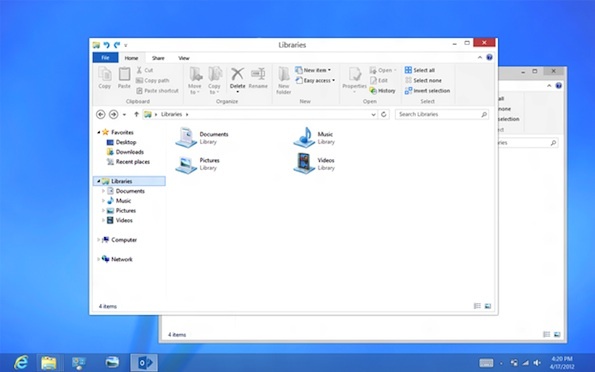Microsoft admits Vista was 'cheesy'

Microsoft published a "brief" history of the Windows interface in a blog post that offered some flashes of candour about Vista and Windows 95, and argued that the tablet as we know it today is one device too many. Redmond also said that it is dropping Aero Glass.

Windows 8
(Credit: Microsoft)
First and foremost, Microsoft said it has "moved beyond" Aero Glass on the Windows 8 desktop, in Friday's Building Windows 8 post.
"We spent a lot of energy carefully considering how substantially to update the appearance of the desktop in Windows 8 ...Our primary goal was to bring visual harmony to Windows, while still preserving much of the familiar feel of the Windows 7 desktop, and not sacrificing the compatibility of existing apps," wrote Jensen Harris, director of program management for the User Experience team at Microsoft.
"In the end, we decided to bring the desktop closer to the Metro aesthetic ...We have moved beyond Aero Glass — flattening surfaces, removing reflections and scaling back distracting gradients."
Harris also laid out "a brief history of the Windows user interface" that is anything but brief (true to the blog's prolix style). He then took a tour of the interface from Windows 1 to Windows 8.
Some highlights of "Creating the Windows 8 user experience":
Windows 1 and the "dubious value" of the mouse: Windows 1, released in 1985, was a "rough graphical shell around DOS, primarily to be used with the keyboard," Harris wrote. And the mouse was doomed to fail from the beginning, according to pundits at the time: "Mice are nice ideas, but of dubious value for business users" (George Vinall, PC Week, 24 April 1984); and "There is no evidence that people want to use these things" (John C Dvorak, San Francisco Examiner, 19 February 1984)
Windows 3 and 3.1 and File Manager: "This upgrade bet big for the first time on most users having a mouse," he wrote. And Alt+Tab came into vogue then. "Because getting to ... minimised apps often required moving a bunch of windows out of the way first, the Alt+Tab keyboard shortcut became a very popular way to switch between running programs"
Windows 95 and the nonstarter "Start" button: that Start button didn't live up to its initial billing. "The Start button was so undiscoverable that, despite having the word Start right on it ... text had to be added to the taskbar after early test releases, so that people could figure out how to get started using the programs on their PC." And an interesting sidebar about the IBM Simon mobile phone: "The first ever mobile phone with PDA capabilities, the IBM Simon, was introduced around this time. It weighed almost 1.5 pounds, ran DOS and the only app ever designed for it sold only two copies"
Windows XP was a "garish" experience for some: "Although Windows XP eventually became a major success, some people at the time were frustrated with the changes to the user interface. They found the Windows XP experience to be garish, and users inquired about how to 'downgrade' to previous versions," Harris wrote
Windows Vista now looks "cheesy": this was Microsoft's most panned OS. Harris had relatively little to say beyond describing the Aero as having the "appearance of highly rendered glass, light sources, reflections and other graphically complex textures." But he did add this: "This style of simulating faux-realistic materials ... looks dated and cheesy now, but, at the time, it was very much en vogue"
Windows 8 means not having to carry around a tablet: converge the tablet and laptop, and, presto, you don't necessarily need a tablet. "Windows 8 imagines the convergence of two kinds of devices: a laptop and a tablet. Instead of carrying around three devices (a phone, a tablet and a laptop), you carry around just a phone and a Windows PC," Harris wrote. Of course, this attempts to refute Apple's argument that convergence doesn't always work. "Anything can be forced to converge, but the problem is that products are about trade-offs, and you begin to make trade-offs to the point where what you have left doesn't please anyone," CEO Tim Cook said last month.
Harris also touched on Windows RT, the version of Windows that will run on ARM processors from Nvidia, Qualcomm and Texas Instruments.
Harris argued that the tendency for phones and tablets to "show only one app on the screen at a time" is strictly done to "manage the background activity on the device, so that only apps you are actively using can drain the battery".
"We did feel like only offering 'one at a time' in the Metro-style experience was a bit of a constraint, and not totally true to the Windows history of multitasking. So we evolved Snap for Windows 8. This feature lets you run any two WinRT-based apps side by side, so that you can watch a video while you browse the web."
Via CNET